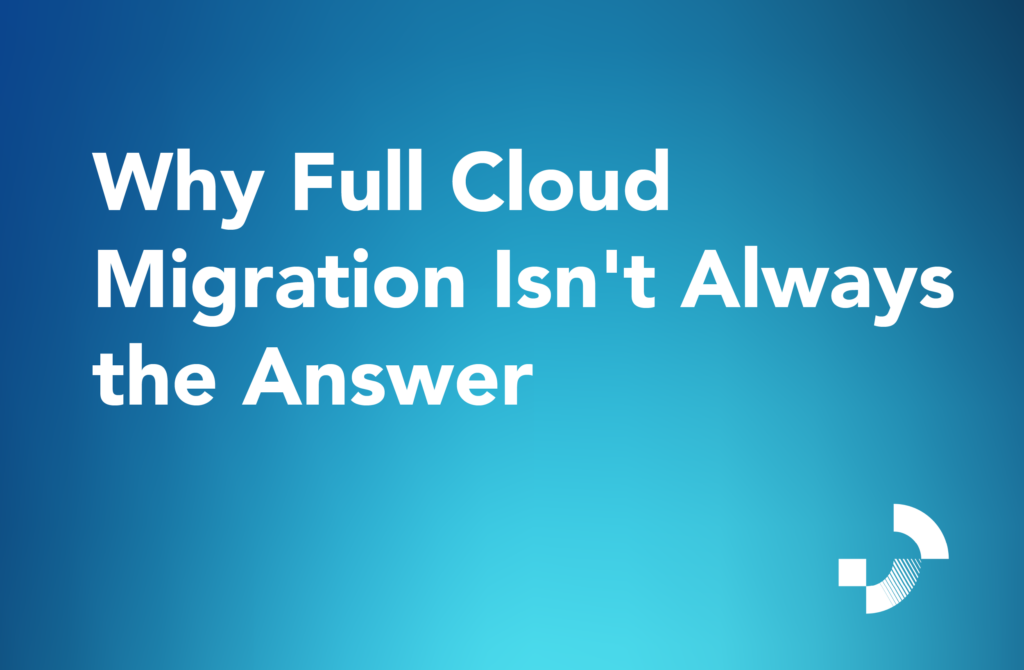Why Full Cloud Migration Isn’t Always the Answer
Over the last decade, the IT world has been flooded with one clear message: “Move everything to the cloud.”
For some organisations, a full cloud migration makes perfect sense. But for many others, the story is more complicated.
In reality, not every system, workload or organisation benefits equally from a cloud-first approach. For many, hybrid IT modernisation offers a more flexible and sustainable solution and can often be a more strategic cloud migration strategy.
Whether it’s due to compliance requirements, cost concerns, operational complexity, or simply what works best for their business model, many organisations find that a hybrid strategy (a mix of on-premise and cloud) is a smarter, more practical path forward.
And they’re not alone.
58% of enterprises globally now operate hybrid IT environments, combining cloud services with critical on-premise systems.
Flexera, 2024 State of the Cloud report
Modernisation isn’t about abandoning what works. It’s about evolving your infrastructure to meet today’s and tomorrow’s needs, smartly and securely.
Why Organisations Choose to Stay On-Prem (At Least Partially)
Despite the growing buzz around cloud migration best practices and strategies, many organisations are choosing to retain significant parts of their infrastructure on-premise.
Regulatory and Compliance Requirements
Certain industries in particular finance, healthcare or government, face strict data privacy and security regulations.
Hosting sensitive data off-site can create compliance headaches and legal risks that many organisations prefer to avoid.
Cost Predictability and Control
While cloud services offer flexibility, they can also introduce unexpected costs, such as fluctuating usage charges, licensing fees, and expensive data egress rates.
On-premise environments, by contrast, provide predictable capital expenditure models and allow businesses to maximise the value of existing assets over time.
Performance and Latency Requirements
Certain applications such as real-time analytics platforms, manufacturing control systems, or high-frequency trading setups require ultra-low latency and guaranteed performance.
Running these workloads on-prem often delivers better reliability and responsiveness.
Existing Investments and Complexity
Organisations with complex legacy systems or highly customised applications face major challenges in migrating everything to the cloud.
Modernising and upgrading on-premise infrastructure can be more cost-effective, less disruptive, and operationally safer than a full rebuild.
Partial Modernisation Challenges
While hybrid environments offer the best of both worlds, partial modernisation isn’t without its challenges. Businesses often face issues like:
Integration Complexity:
Ensuring seamless communication between cloud and on-premise systems requires careful planning, robust APIs, and effective data synchronisation strategies.
Security Gaps:
Hybrid environments must maintain consistent security policies across platforms, a lack of visibility or weak points can expose vulnerabilities.
Resource Constraints:
Managing two environments can strain internal IT teams, especially when legacy systems require specialised knowledge that is becoming rarer.
Operational Silos:
Disparate cloud and on-prem management tools can lead to operational inefficiencies, duplicated efforts, and slower incident response times.
Without the right support, hybrid IT modernisation efforts can become expensive, fragmented and difficult to scale.
How Managed Services Bridge the Gap
This is where Managed Services step in: providing essential cloud enablement without the risk of rushing into a one-size-fits-all solution.
Partnering with a Managed Services provider allows businesses to modernise their on-premise infrastructure without the risks and resource drain of going it alone.
24/7 Monitoring and Support:
Proactive management detects and resolves issues before they impact operations.
Security and Compliance Expertise:
Continuous patching, auditing and policy enforcement ensure that on-prem systems remain compliant and protected.
Optimisation for Performance:
Legacy systems are tuned, upgraded and integrated with cloud components for better efficiency without unnecessary rebuilds.
Scalable Modernisation Planning:
Roadmaps are developed to modernise systems at the right pace, balancing business goals, cost, and risk.
With the right Managed Services partner, partial modernisation can deliver real results without the chaos of a full cloud migration.
Smart Modernisation, Not Blind Migration
The future isn’t purely cloud or purely on-prem. Hybrid IT modernisation helps organisations build efficient and secure environments tailored to their unique needs.
Modernising your on-premise systems doesn’t mean abandoning them. With the right cloud migration strategy and support, you can:
-
Strengthen operational resilience
-
Control costs
-
Enhance security
-
Lay a foundation for future innovation
Smart modernisation is the path forward, not blind migration.
If you’re ready to modernise without compromising what matters most, talk to us about how Park Lane Managed Services can help with your cloud enablement and infrastructure upgrades.






